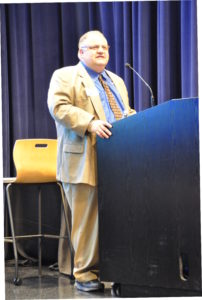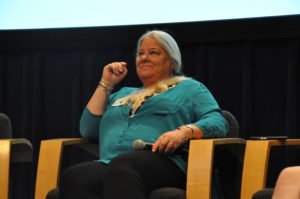By: Michael Bernick

The neurodiversity in employment movement came to our state last week.
On the morning of June 6, over 200 neurodiversity advocates from around the country gathered at the Microsoft campus in Mountain View, for the “Neurodiversity in the High Tech Workforce” conference. The event demonstrated the growing heft of the movement, while also indicating some of the tough questions that lie ahead if the movement is to yield greater results.
This is the second year of the conference, which is the brainchild of Microsoft Sales Specialist, Global Accounts, Stu Shader. Shader himself is dyslexic and was inspired in 2014 when he read The Dyslexic Advantage, which portrayed dyslexia as an advantage rather than a disadvantage in certain jobs. He started the conference to champion the employment skills of persons with dyslexia, autism and other brain wiring conditions. He found a receptive audience among leadership in Sales, and other Microsoft departments.
Tom Bergeron, COO of Inventive Labs, traveled from Amesbury, Massachusetts. Inventive Labs works with aspiring entrepreneurs and Bergeron sees neurodiversity and its job strengths a potential market of entrepreneurs. Educator Susan Fitzell of Manchester New Hampshire, came to learn about job placement opportunities for the teenagers with autism and other conditions, who are aging out of the K-12 special education system. Several social enterprise companies, targeting employment for neurodiverse adults, joined, including three tech ventures, Platinum Bay Technologies in Irvine, California, Aspiritech in Highland Park Illinois, and Specialist Guild, in the Bay Area.
The keynote address was delivered by Steve  Silberman, author of the 2015 best seller NeuroTribes. More than any other book, NeuroTribes is responsible for popularizing the central message of neurodiversity: autism and the other neurodiverse conditions as abilities not disabilities. Silberman urged the group to go beyond the widely debated issues of causation, size of population and definition, and focus on building social, housing and employment structures to better integrate the neurodiverse populations.
Silberman, author of the 2015 best seller NeuroTribes. More than any other book, NeuroTribes is responsible for popularizing the central message of neurodiversity: autism and the other neurodiverse conditions as abilities not disabilities. Silberman urged the group to go beyond the widely debated issues of causation, size of population and definition, and focus on building social, housing and employment structures to better integrate the neurodiverse populations.
Then followed descriptions by several major tech companies that have established targeted hiring and retention programs for neurodiverse adults. SAP’s “Autism at Work” is the most advanced of the recent tech initiatives. SAP currently has 100 adults with autism in its targeted effort worldwide, including 20 in the San Francisco Bay Area. Jose Velasco the head of Autism at Work was joined by Mark Jessen, a participant in the program, who despite his technology skills had been unemployed and even homeless for a number of years before being recruited into the program. Microsoft has established its own “Autism at Work” program, with its first hires in its Redmond offices.
 Jan Johnston-Tyler, president of EvoLibri, a Silicon Valley job placement service focused on neurodiverse adults, spoke of the hunger for employment she saw among her clients. Paulette Penzvalto, a woman with autism who is employed at Google, talked about her own successful journey from marginal employment to the tech giant.
Jan Johnston-Tyler, president of EvoLibri, a Silicon Valley job placement service focused on neurodiverse adults, spoke of the hunger for employment she saw among her clients. Paulette Penzvalto, a woman with autism who is employed at Google, talked about her own successful journey from marginal employment to the tech giant.
Other major tech companies were well-represented in the audience: Apple, Google and Facebook. At the conclusion of the program, participants were slow to leave. There was good feeling toward Microsoft for hosting, and a discussions of how the neurodiversity proponents could work together, especially throughout California.
Yet, despite the positive, the conference reinforced certain tough questions about employment that the neurodiversity movement will need to address in California and elsewhere if it is to move to the next level. Chief among these are the following four:
- Why aren’t more companies, especially tech companies, adopting the active neurodiversity efforts of SAP and Microsoft? Diversity is a frequently-heard phrase throughout the Silicon Valley today, with companies creating or expanding diversity departments. For the most part this diversity is focused on race, ethnicity and gender categories. The diversity push though has yet to embrace neurodiversity.
- Does the talk of neurodiversity and workforce culture have any meaning? Reference was made at the conference to developing a workplace culture of greater inclusion for neurodiverse adults—a culture of greater flexibility and patience. But few specifics were given. What is the more flexible workplace culture envisioned? How is to be achieved?
- Does a percentage of the neurodiverse population really possess unusual talents that can be better utilized in the job market? Reference also was made at the conference to the special skills possessed by neurodiverse adults—skills of pattern recognition and memory recall among adults on the autism spectrum, skills of hyper-focus among adults with ADHD, spatial thinking skills among adults with dyslexia. But how widespread are these skills? And how are they connected to individual job openings?
- What of the majority of the neurodiverse population who may not possess unusual skills, where do they fit into the job market? While neurodiverse adults, like Mark Jessen of SAP, possess unusual tech skills formerly overlooked, it may be that the majority of neurodiverse adults do not possess these skills. Nearly all express a desire to work and a frustration of their current situation. How can they be better fit into the job market? Is there a role for a form of public service employment for the neurodivers.
The neurodiversity movement will continue to grow in 2016, as more and more Americans have a relative, or neighbor, or acquaintance with autism or other neurodiversity. Also, the employment challenge will only grow, as new forms of job structures, with less stability, emerge. So we say hurray for Stu Shader, and hurray for Microsoft. But now for the hard part.

